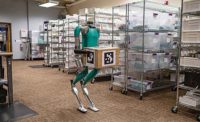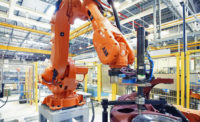
When preparing parts for assembly, automakers can always use an extra hand or two. One automaker has found those hands at the end of a dual-arm robot by the Motoman Robotics Div. of Yaskawa America Inc.
For the past four years, the automaker has used the dual-arm robot to shorten the cycle time to treat the front and back surfaces of a suspension component. Shortening cycle time is part of the company’s lean manufacturing practices.
Before using the dual-arm robot, the company used a single-arm robot mounted on a stand in front of the CNC machine. The robot loaded a part into the machine-which machined the part’s front surface-then reached into the machine, retrieved the part, mounted it on a flip stand, regripped it and reloaded it into the machine so the part’s back side could be machined.
With the dual-arm robot, its hands and forearms work within the CNC machine. Thus, the right hand loads the part into the machine, and the left hand retrieves the part after its front has been machined. The left hand gives the part to the right hand, which reloads the part to machine its back side. The hands do not need to regrip the part, enabling the automaker to shave fractions of a second off the cycle time-fractions that add up to significant savings over the course of days, weeks and years.
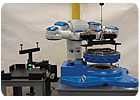
Assemblers and dual-arm robots often use the same
tools to do their jobs, such as lift-assist devices. Photo courtesy Motoman Robotics
Division of Yaskawa America Inc.
Human-Scale Automation
Creating dual-arm robots with humanlike flexibility has been a priority at Motoman since the late 1990s. Motoman sought to leverage the work done on dual-arm control and dexterous manipulators by academia and bring it to industrial robots.Motoman made two design breakthroughs in the early 2000s that helped it create dual-arm robots manufacturers could use for assembly. The first was to internally route the robot’s electrical and pneumatic lines through hollow-bore actuators rather than mount them externally. Doing this also increased the arm’s dexterity.
The second design change was creating a seven-axis robotic arm, which has 50 percent more dexterity than a six-axis articulated arm.
“The six-axis arm allows multiple positions and orientations but just one configuration per pose,” says Erik Nieves, technology director for Motoman. “However, the seven-axis arm offers many configurations, like a human arm.”
Motoman introduced its first dual-arm prototype in 2004, the DA9IC. The robot offered coordinated and independent control of up to 11 axes of motion, but had neither shoulders nor a humanlike appearance. Some units are still used to load and unload parts for assembly machines.
After further research and refinements, in 2005 Motoman introduced the DA series, its first true dual-arm robots incorporating the new actuators. The DA10 and DA20 are 13-axis robots-consisting of two crablike, six-axis arms and a rotating torso-with individual arm payloads of 10 and 20 kilograms, respectively.
The company introduced its second-generation dual-arm robot, the DIA10, in 2006. It offers 15 axes of movement: two seven-axis arms and a rotating and bending torso. Motoman also gave the DIA10 humanlike shoulders and arms, each of which has a payload capacity of 10 kilograms.
These features allow the DIA10 to maneuver in very tight areas. For example, when the DIA10 extends its arms vertically, they reach a height of 1,440 millimeters, but the robot takes up only 1 square foot of floor space. The robot’s arms can be straightened out horizontally to reach 1,100 millimeters in each direction at a height of about 2 feet above the floor. This maneuverability enables manufacturers to position the DIA10 between machines or out of the normal working area in a floor-, ceiling or wall-mounted configuration.
“On the latest generation SDA series [Motoman’s current series], we slimmed down the shoulders significantly by shortening the shoulder joint,” says Nieves. “We also mounted the arms forward of the torso to increase the work envelope.”
The SDA series consists of three units: SDA10D, SDA20D and SDA5D. Their individual arm payloads are 10, 20 and 5 kilograms, respectively.
Nieves says the arms of the SDA10D are much faster than those of the DIA10 and can operate any type of gripper. Each arm extends 1,970 millimeters horizontally and 1,440 millimeters vertically. The robots can be mounted on an optional base that swings out to increase their reach and capability.
All three models are being used for assembling automotive parts, as well as electric motors and appliances. The SDA10D is also used for degating operations in plastics manufacturing and handling containers of toxic substances in nonindustrial applications.
“SDA dual-arm robots can be used in any application where labor involves a specific series of tasks,” says Nieves. “The robot is intended to fit where a person has been.”
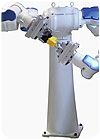
SDA5D robots have
individual arm payload capacities of 5 kilograms. Arms on the SDA series can operate any type of gripper. Photo
courtesy Motoman Robotics Division of Yaskawa America Inc.
Frida
Several years ago, ABB began research and development on a dual-arm robot. In early 2009 the company joined the FP7-funded Rosetta project, which seeks to develop “human-centric” industrial robots that cooperate with workers safely and intuitively.This past April, the company announced it had developed a prototype called Frida that is being tested in various industrial applications. Most of the remaining research work on Frida is being done as part of the Rosetta project.
The robot is designed to meet the agile production scenarios frequently found in the consumer electronics industry and other market sectors. According to the project briefing, Frida fits into spaces ergonomically designed for human workers and can be easily interchanged with a human co-worker when the production order is changed or a new layout is required.
Frida is a 15-axis robot that features two seven-axis arms, flexible grippers flanked with suction cups and a bending torso with integrated IRC5 controller. All cabling is routed internally right through to the gripper flange. The robot can be connected to vision cameras.
Frida can operate in tight spaces and be mounted on a workbench or hung from a wall. Its arms have a reach similar to that of a small adult and can reach components below its base. Frida features a single-phase power connector that can be installed anywhere within an assembly line.
Safety and agility are the main design criteria for Frida. To enhance safety, the robot has low payload and inertia, power and speed limitations, and software-based collision detection. All surfaces of the robot are smooth and free of pinch points and sharp edges. Exposed regions are covered with soft padding.
The robot’s arms are designed so no human body part can be clamped between the axes. Pinch points between the two arms or between one arm and the robot body are eliminated by the physical limits of the drivetrain. If a clamping force is detected, the collision detection software will turn off the motors, further reducing the risk of injury. Special focus has been placed on the arms’ agility in narrow spaces, employing seven-axis kinematics for each arm. Frida features kinematic redundancy, enabling the robot to maneuver its elbows independently from the tool center point.
This functionality enables the development of automatic collision avoidance algorithms and ensures that the arms are always moving along collision-free trajectories, without user involvement. A quick attachment interface is mounted to the gripper flange and provides process air and signals to the affixed tool.
The robot was designed to be easily portable between assembly stations and enable combined work with manual labor at low risk without additional safety requirements. The intent is to reduce the threshold for automation. The investment cost for the robot was also minimized to enable a reasonable payback time.
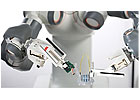
Frida is a 15-axis dual-arm robot prototype that
features two seven-axis arms, flexible grippers flanked with suction cups and a
bending torso with integrated controller. Photo courtesy ABB
WAM Arm
Since March 2010, Barrett Technology Inc. has been part of the Defense Advanced Research Projects Agency (DARPA) autonomous robotic manipulation program, which hopes to develop software and hardware by 2014 that lets a robot autonomously manipulate, grasp and perform complicated tasks after receiving high-level direction.In summer 2010 DARPA unveiled its initial dual-arm robot, which features two Barrett WAM arms that can lift and place various objects.
Around the same time, the Intel Personal Robotics Lab unveiled HERB, a robot that features dual WAM arms, three-pronged grippers and a Segway RMP mobile base. HERB can pick up various small items, offer them to people and place them in a different area while avoiding obstacles. This robot also is being used as a research platform at Carnegie Mellon University.
Apart from these dual-arm robots, the single WAM arm has been used in manufacturing, surgical, space and research applications. The arm is highly responsive to contacts all across its link surfaces, not just at the tip end. It does not rely on active force or torque sensors; rather it precisely controls motor current.

In the future, dual-arm robots will become true production
partners with human assemblers. Graphic courtesy Motoman Robotics Division of
Yaskawa America Inc.
Looking Ahead
Nieves says the future of dual-arm robots in manufacturing is a bright one-a future where these robots become true production partners with human assemblers. He cites two reasons for his optimism.The first is that people and dual-arm robots already are using the same tools to do their jobs, such as torque wrenches, nutrunners and even lift-assist devices. The second reason is the revised ISO 10218 standards for industrial robot safety, which he believes will help promote human-robot assembly line collaboration.
“The new standards enhance both machine safety and worker safety,” says Nieves. “They help manufacturers take down the fence and achieve successful integration.”

